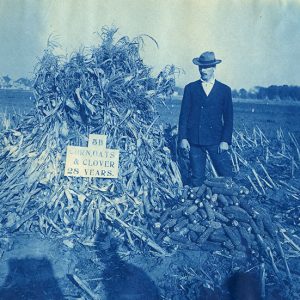
Whether he worked south of the Quad or in southern Illinois, every innovation Cyril G. Hopkins made started with soil.
In 1894, Hopkins received a position as the chemist of the Agriculture Experiment Station at the University of Illinois. Hopkins’s doctoral thesis “The Chemistry of the Corn Kernel” revealed the driving themes of Hopkins’s twenty-five year career with the University of Illinois: chemistry and agriculture.
In particular, Hopkins analyzed the chemical composition of soil. Hopkins worked to create a system of permanent agriculture. By “permanent agriculture,” Hopkins meant a system by which farmers make the soil better, rather than poorer, through their farming practices.
During his journey towards permanent agriculture, Hopkins identified six positive factors of crop production: the seed itself, a home for the seed, food to nourish the seed, moisture, heat, and light. Of these six factors, Hopkins focused on food. Using his chemistry background, Hopkins distinguished ten essential elements of plant food. Out of the ten, he singled out phosphorus and nitrogen as the two farmers could most easily influence.
Many people offered blanket remedies for the problems farmers faced. Hopkins advocated for a more individualized approach. For example, not all farmers needed to apply the same amount of phosphorus or nitrogen depending on what already existed in the soil. Hopkins passionately supported a soil survey for the state of Illinois and now many county soil surveys have taken place since 1899. Farmers could then determine what their individual soil needed because of these surveys.
During the late 1800s, antagonism existed between scientists and farmers. Hopkins worked to bridge this gap. In the introduction of his book Soil Fertility and Permanent Agriculture he wrote “For the sake of himself and children, it must be said to the practical farmer that he should encourage the teaching of the science of agriculture in the school, even though he may know much more than the teacher concerning the art of agriculture,” (Hopkins, 1910). Despite being a scientist by training, Hopkins felt comfortable with farmers.
Throughout his career, Hopkins worked to simplify complex concepts. He wrote Soil Fertility and Permanent Agriculture not only for students, but with farmers in mind. Hopkins even wrote a children’s book about permanent agriculture which included information for parents and teachers to order other pamphlets free of charge.
In Hopkins’s children’s book The Story of King and Queen, the title refers to ______________________________ who reign over a kingdom in “the Land of the Illini which stretched away farther than the eye could see…”
a. King Carmel and Queen Honey
b. King Nitrogen and Queen Alfalfa
c. King Corn and Queen Clover
d. King Soil and Queen Legumes
C. King Corn and Queen Clover
Although Hopkins was born on June 22, 1866, in Minnesota and spent his early life in South Dakota, he dedicated most of his life to the soil of Illinois. In one pamphlet, Hopkins wrote “If the greatest study of mankind is Man, the next greatest study is the soil; for upon the soil depends the preservation of agriculture, the prosperity of industry, and the progress of man,” (Hopkins, 1918). According to Hopkins, every story started with soil.
After having the opportunity to analyze soil farmers used for thousands of years in Greece, Hopkins contracted malaria and died on October 6, 1919, at the British Military Hospital at Gibraltar. Upon Hopkins’s death, Frank S. Haynes, the president of the Illinois Farmers’ Institute wrote, “The soil of Illinois has lost the best friend it has ever had…” (1922).
To remember Hopkins at the University of Illinois, you can stop by Hopkins Hall at the Ikenberry Commons. You can also stop by the Morrow Plots where Hopkins completed some of his experiments. Across the state of Illinois and the corn belt beyond, the enduring fertility of the soil memorializes Cyril G. Hopkins and his goal of achieving permanent agriculture.
– Morrow Plots. Hopkins completed some of his experiments here.
– Hopkins Hall. The Residence Hall named after Hopkins.
University of Illinois. (1922). Cyril George Hopkins. Urbana: University of Illinois Press. The following sources were found in Record Series 8/6/21 from the University of Illinois Archives: Hopkins, C. G. (1918). Permanent Soil Improvement. Birmingham, Ala.: Tennessee Coal, Iron, & Railroad Company. Record Series 8/6/21. Box 2. Hopkins, C. G. (1910). Soil Fertility and Permanent Agriculture. Boston: The Athenaeum Press. Record Series 8/6/21. Box 2. Hopkin, C.G. (1910). The Story of a King and a Queen. Circular No. 145. Agricultural Experiment Station University of Illinois. Record Series 8/6/21. Box 2.
